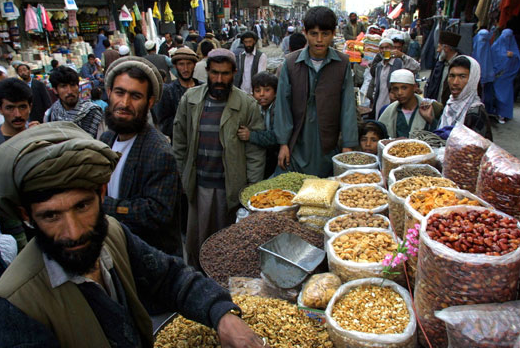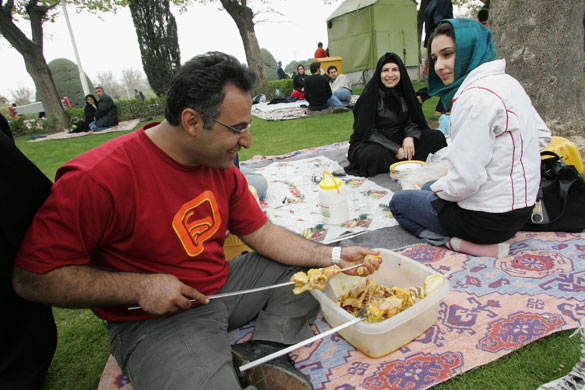We’re pleased to feature a post by Robert Hariman. Robert is a professor of Rhetoric and Public Culture in the Department of Communication Studies of Northwestern University. Robert blogs at No Caption Needed, where we saw this great post:
—————————
I am suspicious of references to “the Arab Street,” particularly when the phase is applied–as it often is–to nations and other vast swaths of territory that are not Arab or not exclusively Arab. Several years ago Christopher Hitchens declared that it was a vanquished cliche but he was misusing it himself and not surprisingly as he was blowing the war trumpet for the Bush administration. And he wasn’t speaking of its persistence as a visual convention.
The caption of this photograph at The Guardian says only, “Nowruz celebrations in Afghanistan.” Nowruz is the name of the Iranian New Year, which is celebrated in a number of countries by people of several faiths. The baskets of dried fruits eaten during the holiday provide the only visual connection to the colorful festivities, and you have to know more than the paper tells you to see that. For many viewers, this will a thoroughly conventional image of the Middle East.
That image is one of throngs of working class men massed together in the street. What little business is there is in the open air markets lining each side of the densely packed urban space. We see small batches of everyday goods on display–probably to be bartered for, no less. The open baskets of food are a sure marker of the underdeveloped world. (Imagine how many packages it would take to wrap up all that fruit for individual snacks to be sold in the US; and even in Whole Foods the unpackaged food is in closed bins.) Everything fits together into a single narrative, but the masses of men and boys make the scene politically significant. This is the place where collective delusions take hold, where mobs are formed, and where unrest can explode into revolutionary violence and Jihad.
Which is why I get a kick out of this photograph of another Nowruz celebration.
The caption reads, “An Iranian man skewers chicken for grilling as he picnics with his family.” My first thought when I saw the image was to check and make sure it wasn’t taken in Chicago. This also is a very familiar scene: grass, blankets, families and friends, plastic containers of food, dad getting ready to do the grilling.
What is astonishing is that I was able to see them at all. A typical summer holiday photo becomes a radical disruption of Western visual conventions when taken in Iran and shown in the US. Of course, it wasn’t shown in the US: this, too, is from the UK paper.
In this photo, there is no Arab street nor Iranian masses dominated by Mullahs and demagogues. A middle class tableau reveals that so much of what is in fact ordinary life for many people in Iran and elsewhere in the Middle East is never seen in the US. And it isn’t seen because it doesn’t fit into simplistic categories, outdated stereotypes, and a dominant ideology. All that is shown and implied in the cliches is of course also there, but it is there as part of a much more complex and varied social reality.
As evidence of how things might appear a bit different, notice how seeing the second image can affect perception of the first one. In the second, it seems evident that the family is posing for the photograph. They’re doing exactly what they would have been doing but now with the additional, amused awareness that it is, for a moment, also an act. And sure enough, if you look back to the first photo, you can see the same thing. And if you can see that, they no longer need appear as a mass, or poor, or threatening, or anything but people enjoying a holiday. Much like people in the US were doing this past weekend to celebrate St. Patrick’s day, thronged together, in the street.
Photographs by Natalie Behring-Chisholm/Getty Images and Behrouz Mehri/AFP-Getty Images.



Comments 13
Elena — March 25, 2009
That image is one of throngs of working class men massed together in the street. What little business is there is in the open air markets lining each side of the densely packed urban space. We see small batches of everyday goods on display–probably to be bartered for, no less.
Compare: Flohmarkt (flea market) in Wuppertal, Germany, Rastro (street market) in Madrid, Spain.
macon d — March 25, 2009
Excellent work disrupting what amounts to an "Orientalist" mindset, a collective psychosis. Thank you for reposting this!
Ranah — March 25, 2009
The animated movie "Persepolis" is told through the eyes of a girl born in Iran.
In it one can see that in their personal life, people in Iran have a lot in common with us.
Western images of the ‘Muslim world’ « Eclectic Grounds — March 27, 2009
[...] a comment » A great post by Robert Hariman published at Sociological Images. Hariman compares two photographs of the Iranian New Year celebrations in Afghanistan and Iran. [...]
David A — March 29, 2009
It's an important thing to keep in mind that Afghanistan and Iran are vastly different countries, with vastly different peoples.
That being said, people are people.
kaolin fire — March 30, 2009
Thank you so much for this. Perspective and context are magical things.
AJ — March 30, 2009
I note that the top image shows only men, where the second shows a man and two women. In the top image, no one is smiling. All three people are smiling in the second. Does the lack on women and the lack of smiling make the top image "less civilized"? Is the top image "less civilized" because the people portrayed probably of a lower class?
Then comes my problems with the word "civilized"...
Joe — March 30, 2009
I can't make heads or tails of this post. Both of these pictures are from The Guardian but the author uses them to make a point about the depiction of the Middle East in American media. There is no attempt, however, to actually show how Nowruz is represented America. As an actual example, here is a story from the New York Times. Check out the slide show embedded in the story. Most of the photos are of seemingly middle-class Tehranians doing all sorts of shopping (what could be more Western than that?). It certainly seems to run counter to the author's claim about what can't be seen here.
yahoooo — April 28, 2009
Hi, I found your site using yahoooo, does your site support firefox?
yahoooo — April 28, 2009
Hi, I found your site using [url=http://www.yahoooo.com]yahoooo[/url], does your site support firefox?
Stinky19 — October 22, 2009
You're the same as all the others. ,
Photographer Tried for Defamation » Sociological Images — January 29, 2010
[...] seen the same phenomenon with photos of the Middle East, Appalachia, American Indian art, Africa (see both here and here) and, I’ve argued, the TV [...]
Uzbek Tempest in the Soc Images Teapot « Formless and Void — January 30, 2010
[...] and gender in American media. Their coverage of how Americans represent other cultures can also be insightful. In particular, the authors disavow the tendency of Westerners* to “exoticize” the [...]